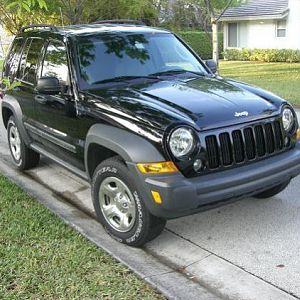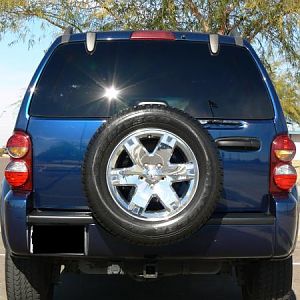Working on a cool project for the KK.
I built a trunk box with a tool drawer back in 2014, and it has some additional space behind the rear seats for a washer fluid bottle and some picnic blankets. It started out as a drawing and ended up being made out of wood.
The trunk, measured very carefully:
Box design:
The real thing being built:
Carpeted to match the Jeep's interior. This is the forward view showing the cubby behind the rear seats.
And installed. The drawer stores tools, recovery gear, and a first aid kit, among other things.
In 2024 I am repurposing part of the space behind the rear seats by building a custom lithium iron phosphate battery that will live back there. It will power my camping fridge and charge using solar panels on the roof rack. It will also run an inverter. Basically it’s a DIY solar generator that fits in my KK. At 74 amp hours I can power stuff even when the Jeep is off. I promised to post some pics of the project so here you go.
This is the battery box I built.
It fits 4 lithium iron phosphate cells, which together make a 12 volt (13.2 volt nominal) battery. This one stores 74 amp hours.
Test fitting it in the trunk box behind the back seats ... it fits! And there is still room for a bottle of washer fluid.
Next came actually building the battery. The cells have to be monitored and protected by a battery management system (BMS) computer so they don't under or over charge. I mounted the BMS on the front face of the box. It is on the right side. On the left is a 5 inch touch screen. On the top of the battery you can see how I tied the cells together using copper buss bars that I made. Under that red hooded thing is a 100 amp MBRP fuse for safety.
A closer look at the front. The touch screen displays a readout of the battery and its various components, as well as lets me change the battery settings. The computer that runs the touchscreen is a Raspberry Pi 3B+ which you can buy for $40. It's running Victron's Venus OS. The Raspberry Pi is attached to the left side of the box. In this photo it still has some blue painter's tape on it. Oops! So much for professional looking images.
The Raspberry Pi's power source is the black box on the lower left. It converts 12 volt to 5 volt power, which is what the RPi uses. The blue box directly under the RPi is a Victron smart relay. The relay turns on two beehive heating pads that are located under the battery cells, to keep them warm when charging the batteries in winter. It turns out LiFePO4 batteries cannot be charged below freezing without killing them. The RPi senses the battery temperature and controls the relay, which activates the heating pads when the batteries are below 39 degrees F (2 degrees C) and it wants to charge them.
On the other end of the battery is a fuse box with 6 circuits and ATO fuses. Right now the two fuses you see are for the battery heater and the Raspberry Pi computer. The 4 other circuits will be for front and rear 12 volt outlets, as well as rear flood lights and front ditch lights (which don't exist yet but hopefully will soon). The idea is to be able to keep devices and lights on for a long time without having to idle the Jeep's engine or kill the starter battery. The 12 volt outlets will be for my camping fridge, as well as charging phones and computers. I do a lot of camping for my field work and research as a forest ecologist, so these things will be helpful.
Here is the whole battery in front of a 20x40" solar panel (100 watts) for scale. The battery is actually pretty compact and small. I'm going to mount a couple of these 100 watt panels on the roof rack and run them in series. I like the idea of not having to run the Jeep to charge the battery. I know I could use a DC to DC converter to charge from the Jeep's alternator but I already had a solar charge controller and the two panels kicking around the basement. Plus it will look cool.
The solar charge controller is on the left and a 375 watt inverter is on the right. The inverter has a household GFCI outlet with a pure sine wave output, which is a very clean power source (no buzzing or distortion). The inverter could run power tools or my coffee grinder, or charge anything with a 120 volt power brick. Coffee is not optional when camping. Those devices will live on the side of the trunk box, where the Jeep's amplifier would be if it came with that option (it didn't).
Finally here is the battery in its new native habitat. It will be bolted in securely and will be completely invisible when the rear seats are up. The battery's touchscreen can be accessed by putting the passenger rear seat down or by using Victron's bluetooth connectivity on a smart phone.
The two solar panels will be installed up here. I am still working on how to route the solar power cables into the cabin without drilling.
I built a trunk box with a tool drawer back in 2014, and it has some additional space behind the rear seats for a washer fluid bottle and some picnic blankets. It started out as a drawing and ended up being made out of wood.
The trunk, measured very carefully:
You must be registered for see images attach
Box design:
You must be registered for see images attach
The real thing being built:
You must be registered for see images attach
Carpeted to match the Jeep's interior. This is the forward view showing the cubby behind the rear seats.
You must be registered for see images attach
And installed. The drawer stores tools, recovery gear, and a first aid kit, among other things.
You must be registered for see images attach
In 2024 I am repurposing part of the space behind the rear seats by building a custom lithium iron phosphate battery that will live back there. It will power my camping fridge and charge using solar panels on the roof rack. It will also run an inverter. Basically it’s a DIY solar generator that fits in my KK. At 74 amp hours I can power stuff even when the Jeep is off. I promised to post some pics of the project so here you go.
This is the battery box I built.
You must be registered for see images attach
are wIt fits 4 lithium iron phosphate cells, which together make a 12 volt (13.2 volt nominal) battery. This one stores 74 amp hours.
You must be registered for see images attach
Test fitting it in the trunk box behind the back seats ... it fits! And there is still room for a bottle of washer fluid.
You must be registered for see images attach
Next came actually building the battery. The cells have to be monitored and protected by a battery management system (BMS) computer so they don't under or over charge. I mounted the BMS on the front face of the box. It is on the right side. On the left is a 5 inch touch screen. On the top of the battery you can see how I tied the cells together using copper buss bars that I made. Under that red hooded thing is a 100 amp MBRP fuse for safety.
You must be registered for see images attach
A closer look at the front. The touch screen displays a readout of the battery and its various components, as well as lets me change the battery settings. The computer that runs the touchscreen is a Raspberry Pi 3B+ which you can buy for $40. It's running Victron's Venus OS. The Raspberry Pi is attached to the left side of the box. In this photo it still has some blue painter's tape on it. Oops! So much for professional looking images.
You must be registered for see images attach
The Raspberry Pi's power source is the black box on the lower left. It converts 12 volt to 5 volt power, which is what the RPi uses. The blue box directly under the RPi is a Victron smart relay. The relay turns on two beehive heating pads that are located under the battery cells, to keep them warm when charging the batteries in winter. It turns out LiFePO4 batteries cannot be charged below freezing without killing them. The RPi senses the battery temperature and controls the relay, which activates the heating pads when the batteries are below 39 degrees F (2 degrees C) and it wants to charge them.
You must be registered for see images attach
On the other end of the battery is a fuse box with 6 circuits and ATO fuses. Right now the two fuses you see are for the battery heater and the Raspberry Pi computer. The 4 other circuits will be for front and rear 12 volt outlets, as well as rear flood lights and front ditch lights (which don't exist yet but hopefully will soon). The idea is to be able to keep devices and lights on for a long time without having to idle the Jeep's engine or kill the starter battery. The 12 volt outlets will be for my camping fridge, as well as charging phones and computers. I do a lot of camping for my field work and research as a forest ecologist, so these things will be helpful.
You must be registered for see images attach
Here is the whole battery in front of a 20x40" solar panel (100 watts) for scale. The battery is actually pretty compact and small. I'm going to mount a couple of these 100 watt panels on the roof rack and run them in series. I like the idea of not having to run the Jeep to charge the battery. I know I could use a DC to DC converter to charge from the Jeep's alternator but I already had a solar charge controller and the two panels kicking around the basement. Plus it will look cool.
You must be registered for see images attach
The solar charge controller is on the left and a 375 watt inverter is on the right. The inverter has a household GFCI outlet with a pure sine wave output, which is a very clean power source (no buzzing or distortion). The inverter could run power tools or my coffee grinder, or charge anything with a 120 volt power brick. Coffee is not optional when camping. Those devices will live on the side of the trunk box, where the Jeep's amplifier would be if it came with that option (it didn't).
You must be registered for see images attach
Finally here is the battery in its new native habitat. It will be bolted in securely and will be completely invisible when the rear seats are up. The battery's touchscreen can be accessed by putting the passenger rear seat down or by using Victron's bluetooth connectivity on a smart phone.
You must be registered for see images attach
The two solar panels will be installed up here. I am still working on how to route the solar power cables into the cabin without drilling.
You must be registered for see images attach










